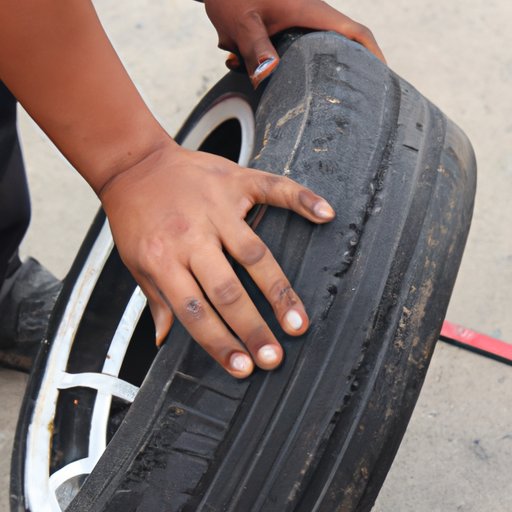
Introduction
Whether you’re on an extended road trip or commuting to work, a flat tire is a frustrating and potentially dangerous experience. While some tire damage may require a full replacement, many common tire problems can be fixed with a patch. In this article, we’ll show you how to patch a tire and provide tips for properly maintaining your tires in the future.
Step-by-Step Guide
The process of patching a tire may seem intimidating, but with the right materials and techniques, it’s a fairly simple task. Here’s a step-by-step guide:
- Remove the tire from the wheel using a tire iron or wrench.
- Locate the puncture or damage on the tire.
- Clean the area around the damage with a wire brush or sandpaper.
- Apply a rubber cement to the damaged area.
- Insert the tire patch into the hole using a patch tool.
- Use a roller or block of wood to press the patch firmly into place.
- Wait for the patch to dry before remounting the tire onto the wheel.
- Inflate the tire to the proper pressure and check for any remaining leaks.
Video Tutorial
For a visual demonstration of this process, check out our video tutorial:
Common Tire Problems and Patching
Tire damage can be caused by a variety of factors, including sharp objects on the road, wear and tear, and overinflation or underinflation. Some of the most frequent tire problems people encounter include:
- Punctures or cuts in the tire
- Small leaks caused by debris on the road
- Slow leaks due to a faulty valve stem
While not all tire damage can be repaired by patching, many common problems can be fixed with a patch. To determine if your tire can be patched, consider the location and size of the damage as well as the wear and age of the tire. If the damage is on the sidewall or if the tire is nearing the end of its lifespan, replacement may be a better option.
Safety Tips
As with any DIY project involving sharp tools and hazardous materials, it’s important to take proper safety precautions when patching a tire. Be sure to wear gloves and safety glasses to protect your hands and eyes from debris and chemicals. Additionally, proper tire inflation is crucial to your safety on the road, so be sure to check and adjust your tire pressure regularly.
Emergency Tire Repair Kit
Flat tires can strike at any time, so it’s a good idea to be prepared with an emergency tire repair kit. Here’s what your kit should include:
- Tire sealant or rubber cement
- Tire patches and a patch tool
- A tire pressure gauge
- A tire iron or wrench
- A can of compressed air or a portable air compressor
By having these tools on hand, you’ll be able to quickly patch a tire and get back on the road.
Best Practices for Tire Maintenance
While flat tires can be a frustrating and inconvenient experience, proper tire maintenance can help prevent the need for patching in the first place. Here are a few best practices for maintaining your tires:
- Check tire pressure regularly and inflate to the recommended PSI
- Rotate your tires every 5,000 to 7,500 miles to promote even wear
- Inspect tires for signs of wear and damage, including cracks, bulges, and punctures
- Replace tires every 5-6 years, even if they appear to be in good condition
By following these guidelines, you can minimize your risk of experiencing a flat tire and help keep your vehicle running smoothly.
Conclusion
Patching a tire may seem like a daunting task, but with the right tools and techniques, it’s a fairly simple process. By following our step-by-step guide and taking proper safety precautions, you can quickly patch a tire and get back on the road. Additionally, by assembling an emergency tire repair kit and following best practices for tire maintenance, you can minimize your risk of experiencing a flat in the first place.




